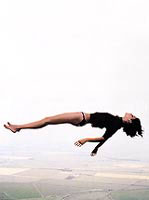The inside out story
John Cooper flicks through Dazed and Confused’s book Inside Out and finds a wealth of glossy and provocative images but not much else

Dazed and Confused has come a long way since its fanzine roots in 1992. It is a thankfully rare commodity: a style mag that takes itself seriously.
This is risky – journalists sound ridiculous when intellectualising about something as superficial as style – and Dazed and Confused rival The Face has made a name for itself while keeping its tongue firmly in its cheek. But Dazed and Confused must be congratulated, if only for its courage to blur the boundaries between art and commercial publishing.
Inside Out celebrates what Dazed and Confused is all about. Publisher Booth-Clibborn Editions has taken risks with offbeat titles exploring street subcultures such as skate photography in Dysfunctional and graffiti in Scrawl: Dirty Graphics and Strange Characters. Inside Out is less ambitious, but certainly looks good.
Designer David James has taken a simple approach. Inside Out is filled with glossy photos, meaning no one has a chance to make a fool of themselves trying to explain what the book is about. The lack of text accentuates the photos, with graphics kept minimal. So minimal, in fact, as to be virtually illegible. Charcoal grey on black is a strain on the eyes; bright yellow on white makes you squint so much that your eyes are barely open.
First impressions are of fashion spreads without the clothes credits. The opening pages, depending which side you start from (like the magazine, Inside Out is split into two halves), are titled I Didn’t Recognise You With Your Clothes On, by Phil Poynter. It is an amusing, provocative collection of images of clothes hung, Invisible Man-style, on non-existent people.
Other stories – there are no words, but virtually everything has a tale to tell – are more effective. Pain by Rankin is a masochistic collection of rich, monochrome photos owing much to the work of Robert Mapplethorpe. Glove Love, by Jake and Dinos Chapman, is hilarious in the way that it takes benign rubber gloves and turns them into sick little puppets, with explicit genitalia stuck on to them. The gloves are shot cavorting in a variety of erotic positions.
The twisted theme continues with Tokyo Santa by Paul McCarthy. This is St Nick as deranged psychopath – in grotesque Leatherface-mask, waving knives around while covered in blood or red paint. The photos are hypnotic, and anyone who still believes in Santa won’t want to after seeing this macabre creation.
Colin the Photographic Assistant, an illustrated story by Paul Davis, pokes fun at the average Dazed and Confused reader – Colin is 25, shallow, paranoid, hedonistic and dreams about a “work/ live loft in Shoreditch”. This will force even the dumbest reader to take a long hard look at themselves.
Inside Out would make a fine addition to your coffee table, but don’t expect to get a feel for what the magazine is about. There have been other books about magazines – Nova provided a look at the issues and style of the 1960s and 1970s, while Out of Control was a guide to Ray Gun and the graphic design skills of the likes of David Carson and Scott Clum. These books gave an insight into the magazines, but Dazed and Confused’s mission statement seems more vague. Inside Out has capitalised on this, emphasising the artistic side of the organisation, instead of the publishing side.
Inside Out isn’t a Best of Dazed and Confused. The best Dazed and Confused has done is not particularly interesting, and the content of Inside Out is much more entertaining and thought-provoking than an average copy of the magazine.
Inside Out, edited by Mark Sanders and Phil Poynter, is published by Booth-Clibborn Editions, priced £39.99
-
Post a comment



